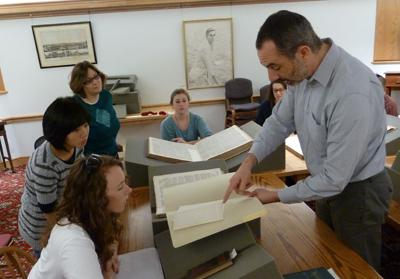“Your welcome letter found me all engrossed in the history of Sulphuric Acid!!!!!”
—Emily Dickinson, first-year student at Mount Holyoke Female Seminary, writing to her brother Austin, February 17, 1848.
Emily Dickinson, scientist?
While the vision of Dickinson hunkered down in a laboratory is more anachronistic steampunk fantasy than reality, it would be similarly foolish to suggest that this insightful woman was oblivious to the leaps in scientific knowledge being made in her time. So say students in Karen Sánchez-Eppler’s course on the poet, in which students closely examine Dickinson in her world.
In a class that meets regularly in the poet’s College Street home, now the headquarters of the Emily Dickinson Museum, students started the semester exploring her background in the sciences. Each year, the course puts different elements of the poet’s life into focus. As a courtesy to the museum for allowing them to use Dickinson’s own house for the classes, students develop their research into exhibits and programs for the museum.
This year, Cynthia Dickinson, director of interpretation and programming for the museum, came up with a head-scratcher of an assignment: Dickinson and dinosaurs.
“Her eyes lit up, and [she] said, ‘I signed up for the Jurassic Road Show, and I am passing that on to you,” Sánchez-Eppler recalled. The museum had volunteered to join other organizations at the mid-October event on the Amherst Common that would attract local professional and amateur geologists and paleontologists, as well as dinophiles of all ages.
It seemed a stretch—dinosaurs weren’t largely identified as such during Dickinson’s lifetime—but not untenable. Amherst does hold a credited place in the development of the field of paleontology. Edward Hitchcock, the third president of the college, was a noted geologist who gathered an extensive collection of fossils (now on public display at the Beneski Museum of Natural History) which were later identified as dinosaur tracks, though he believed they were made by giant birds. His son Edward “Doc” Hitchcock named one of the earliest dinosaurs discovered in America, Megadactylus polyzelus (now known as the Anchisaurus).
While it is true that Dickinson was not versed in velociraptors, Hitchcock’s work was part of her background. Sánchez-Eppler’s students turned to the now-hoary science textbooks that the poet used during her secondary education.
“When we started out, a lot of us thought this connection [between Dickinson and science] doesn’t really exist,” said Claudia Wack ’13. “But it actually did prove to have some substance, once we spent time on it. It was interesting to learn how she was embedded in the moment in a way that is not usually considered.”
Hitchcock’s Elementary Geology was required reading at Amherst Academy (the secondary school whose founders went on to establish Amherst College), and some believe it’s likely that Dickinson attended lectures at Amherst College in its infancy.
The geology bubbles up in Dickinson’s verse:
Volcanoes be in Sicily
And South America
I judge from my Geography
Volcano nearer here
A Lava step at any time
Am I inclined to climb
A Crater I may contemplate
Vesuvius at Home
“This is a poem that people have talked about a lot in terms of her emotional life, that she has a volcano inside of her,” said Sánchez-Eppler. “My class realized, as they were reading her geography textbooks, that they did teach her there were volcanoes in the Pioneer Valley,” in the Mount Holyoke Range, she said.
“When she says ‘a Lava step,’ that is what [the volcanic rock formations] look like. They do look like stairs,”Sánchez-Eppler added.

shows students a fascicle, one of the homemade
books of poetry that Dickinson created
Mary Lyon, founder of Mount Holyoke Female Seminary (now Mount Holyoke College) was a trained chemist, and the school boasted courses in laboratory science, with studies including botany, natural history and astronomy. It’s sometimes lost in discussions of the school’s early religious requirements that Dickinson was also exposed to cutting-edge science at the school, though she was there only a year. (It’s unclear why she left: scholars variously cite homesickness, discomfort with the religious regimen or dissatisfaction with the curriculum).
“There’s a really easy tendency to read Emily Dickinson in a very spiritual manner,” said Justin Knoll ’14, indicating the compulsory religious practices of the times. “But it became clear that [for] some of the things that she is dealing with, the wonders of the world and the big ambiguities, she gives answers both in a spiritual sense and in a science sense.”The principle of the conservation of matter—by which scientists understand that all matter changes but is not destroyed—was another subject of her studies, and apparently a source of comfort:
The Chemical conviction
That Nought be lost
Enable in Disaster
My fractured Trust—
The Faces of the Atoms
If I shall see
How more the Finished Creatures
Departed me!
Sánchez-Eppler is quick to add that introducing the layer of science to Dickinson’s poems does not negate other readings, “but, having paid attention to this, makes other readings possible.” Knoll agreed: “It gives me much more of an appreciation for the universality of her words, because they really can go in a lot of different directions.”
This science unit was a surprising and gratifying start to the course, which will continue to take on other elements of Dickinson’s life as the semester proceeds, said Sánchez-Eppler.
“This is the project I knew least about beforehand, so it is the one I have learned the most about,” she said. “It has changed what I think about some things … I’ve learned a ton.”